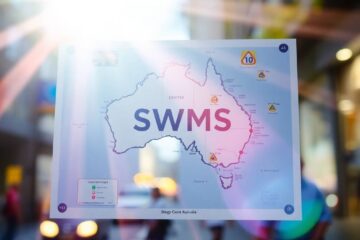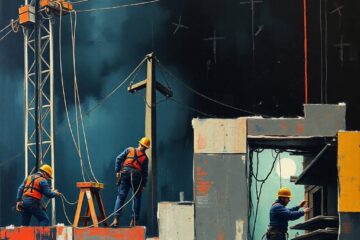Workplace safety signs and symbols play a critical role in protecting workers and maintaining compliance with Australian WHS regulations. These signs communicate important information about hazards, required actions, and emergency procedures, helping prevent injuries and incidents across all industries.
From construction sites to warehouses and offices, understanding what each safety sign means is essential for every worker. In this guide, we’ll break down the main types of safety signs used in Australian workplaces, explain their colours and symbols, and show how they help keep people safe.
Types of Workplace Safety Signs and Their Meanings
There are many different types of workplace signs you might encounter, each with their own unique design and shape. There are six types that are regulated by Australian standards, for safety signage prescribe that certain symbols should be used in specific circumstances. They also prescribe the colours, shapes, and what must be written on the sign.
Warning Sign – Workplace Safety Signs and Symbols
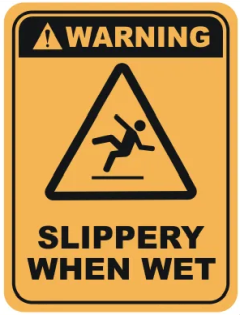
A warning sign is something that indicates possible danger or hazard ahead. This could be anything from a wet floor, to uneven ground, to sharp objects. They are designed to make you aware of the potential risk so you can take the necessary precautions in order to stay safe.
The sign has a yellow background with the word ‘WARNING’ at the top, with a black triangle and a symbol underneath.
Danger Sign – Safety Sign Meanings
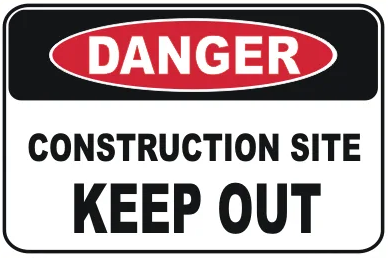
A danger sign is an indication of a risk that could lead to injury or death. These types of signs display the word DANGER in white on a red oval with a black background. These types of signs indicate that you should follow safety protocols precisely, as any deviation could cause serious harm.
Prohibition Sign – Workplace Safety Signs Australia
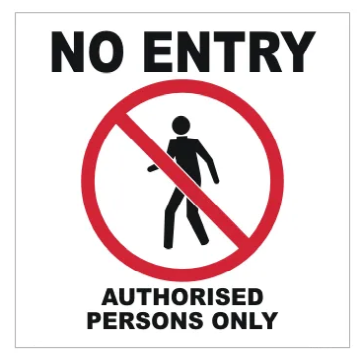
A prohibition sign is something that tells you to not do something. It could tell you to not stand on the carpet, or to not use a particular machine. These signs are put in place for your safety and their placement is determined by experts – including occupational health and safety experts, as well as experts in the industry/field – to ensure that you stay safe. A prohibition sign has a red circle with a red diagonal line over the top of a black symbol.
Mandatory Sign
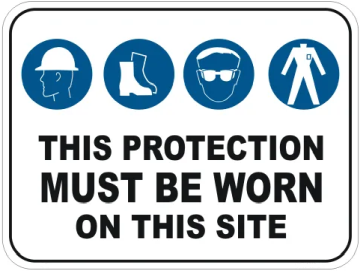
A mandatory sign is something that tells you to do something. They are blue and feature a white symbol in the centre.
These signs usually indicate the need for specific safety equipment, such as ear protection or a hard hat. You will always see these signs in dangerous or hazard-prone work environments, where not following the rules could result in an injury. These types of signs indicate that if you do not follow the protocol, there will be severe repercussions.
Emergency Information Sign
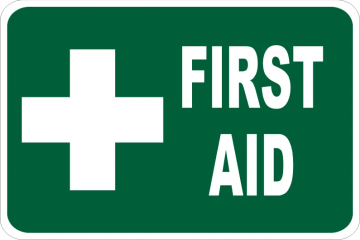
These are tyically green and white signs that are always posted in dangerous/hazardous work environments. They tell you where first aid kits are, where the fire exits are located, and what to do in case of a chemical or biological hazard.
Fire Signs
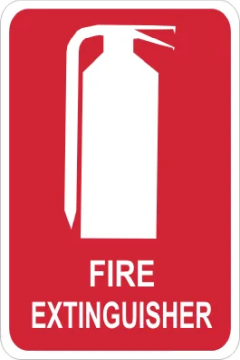
These signs let you know about fire safety equipment and are bright red so easy to see in an emergency. They indicate the location of fire extinguishers, fire blankets and hoses.
Non Regulated Safety Signs
Other safety signage will be general instructions or directions on how to safely use equipment in order to avoid injury. These are for general use in workplaces and inform employees about rules, regulations, potential hazards and safe practices. The wording on these signs should be concise and written in plain language so that workers do not need to use a dictionary to work out what they mean.
Directional sign
These safety signs indicate where a certain area or location can be found. For example, you may come across a sign that indicates the direction to the nearest exit. If you’re ever in trouble and need to get out quickly, it’s important that you know exactly where the exits are located so you don’t get lost trying to find them.
Obstruction sign
This sign indicates that there is an obstruction on the pathway, forcing someone to take another route in order to pass safely. The person may need to go around or even change direction completely, which may require extra care when doing so if it’s more dangerous than the normal path.
Using safety signs in your workplace
In some professions, using safety signage is compulsory – for example, road workers have to use them as part of their work. However, it’s not just those who hold a designated position that may need to put up and sort out signs – anyone could potentially benefit from knowing what the different types mean and what they should be used for.
If you’re looking for ways to keep your workplace safe, using safety signs is a great place to start. You can order customised ones online that suit the needs of your business, or simply use existing ones bought off the shelf from one of many stationery retailers. The important thing is not putting them up, but actually looking at them and following what they say. If you’re not sure, it’s always best to take advice from a professional or contact your regulator. You could conduct a risk assessment to determine if safety signage might be an advantage in your workplace.
Remember if your workplace has customers or visitors you also need to keep them safe and safety signs could be an easy way to do that.
Construction Signs
In the construction industry in Australia there are many signs that are legislated in the regulation such as having a builders sign on the entrance to a construction site.
Guidelines state that builders/construction signs should be durable and appropriate to the environment they are in (e.g. waterproof or fit for outdoors). The colour choice needs to contrast with the background so that it can be easily seen.
They also recommend using symbols instead of text where possible, as this is more universal than words, which could cause confusion when translating them into other languages. Each state has laws around the information that needs to be included such as the builders name, licence number and contact details. This information needs to be easily viewed from a distance.
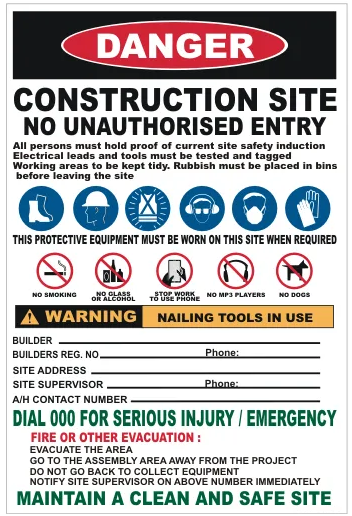
Safety Signage Toolbox Talk in Australian Workplaces
Sometimes people become blind to the safety signs in the workplace as they have seen them so often, and they just become part of the background. So delivering a safety signage toolbox talk is a great way to remind employees of their importance and get them thinking about how they can stay safe.
When delivering the talk, it’s important to emphasise that safety signs are there for a reason and should never be ignored. It’s also worth highlighting any specific signs that may be relevant to the work being carried out at the time. For example, if you’re working with chemicals, you should point out the signs that indicate the dangerous substances.
You should also encourage employees to ask questions if they’re ever unsure about the meaning of a sign. It’s better to ask and get clarification than to ignore it and potentially put yourself in danger.
After the talk, it’s a good idea to put up some sort of reminder, such as a poster, in the workplace so that employees can refer back to it if they need to.
Find out more with 5 Toolbox Talk hints and tips to make your life easier.
How often should a safety sign toolbox talk be given?
It’s recommended that you deliver a safety sign toolbox talk at least once a year, but more frequently if possible. This will ensure that employees are always aware of the signs and their meanings, and it will help to refresh their memory if they haven’t seen them for a while. Plus, of course if you have new team members or have introduced new safety signage, then it’s an ideal opportunity to go through everything again.
How can Safe-R Outcomes help your business?
Our Professional subscriptions contain many essential documents including:
- WHS Management Plans / Safety Manuals
- SWMS (if the job entails high risk tasks)
- a range of SOPs, Registers, Toolbox Talks, Checklists and Policies
These can all be downloaded and are not blank templates, so can be used immediately.
We also provide Induction training to help you on-board new employees and contractors.
As you can see it is all done for you so it makes it nice and simple. You can find out more on the Industries and Professions page.
If you’re concerned about the time commitment and knowledge required to implement the correct documents, procedures and training for forklift safety, Safe-R Outcomes can help. We strive to reduce the time and cost for businesses to implement their legally necessary safety requirements.
Frequently Asked Questions about Workplace Safety Signs
1. What are the different types of workplace safety signs and their meanings?
Workplace safety signs in Australia fall into five categories: prohibition (red), warning (yellow), mandatory (blue), emergency information (green), and fire safety (red with symbols). Each type communicates a specific safety message to help prevent accidents and ensure compliance.
2. Why are safety signs important in the workplace?
Safety signs help reduce workplace injuries and ensure compliance with WHS laws. They provide clear visual warnings and instructions, especially in high-risk environments like construction, warehouses, or workshops.
3. What do the colours of safety signs mean in Australia?
Red usually indicates prohibition or fire-related instructions, yellow warns of hazards, blue signifies mandatory actions, and green provides emergency information. These colour codes follow the AS 1319 Australian Standard.
4. What is the difference between hazard signs and mandatory signs?
Hazard signs (yellow) alert people to potential dangers such as chemicals, electrical risks, or trip hazards. Mandatory signs (blue) instruct people to follow safety rules, like wearing protective eyewear or hard hats.
5. What are the 5 main categories of WHS signs?
The five main types of WHS signs are:
- Prohibition signs (red)
- Warning signs (yellow)
- Mandatory signs (blue)
- Emergency information signs (green)
- Fire safety signs (red with specific fire symbols)
6. How can I train staff to recognise and understand workplace safety signs?
Include WHS sign recognition as part of your staff induction and ongoing safety training. Use visual aids, posters, interactive quizzes, and toolbox talks to reinforce knowledge.
7. Are there standard safety symbols used across Australian workplaces?
Yes. Australian Standard AS 1319 provides consistent symbols for WHS signs, such as fire extinguishers, high voltage, eye protection, and more. These standardised icons help ensure quick and accurate understanding.
8. What safety signs are required in a construction or industrial workplace?
Common signs required include PPE (Personal Protective Equipment) signs, hazard warnings, emergency exits, and fire equipment signs. The specific signs depend on the risks present on the site and relevant WHS legislation.
9. Where should safety signage be placed in the workplace?
Signs should be placed at eye level, near hazards, at entry points, around dangerous machinery, and at emergency exits. Make sure they are clearly visible, well-lit, and not obstructed.
10. Do WHS regulations require specific safety signs?
Yes. Australian WHS laws require businesses to display appropriate safety signage where hazards exist or specific actions are mandatory. Failure to display required signs can lead to legal issues and increased risk of incidents.
What are the different types of workplace safety signs and their meanings?
Workplace safety signs in Australia fall into five categories: prohibition (red), warning (yellow), mandatory (blue), emergency information (green), and fire safety (red with symbols). Each type conveys critical instructions or hazards to ensure safety and compliance.
Why are safety signs important in the workplace?
Safety signs help reduce workplace injuries and ensure compliance with WHS regulations. They quickly communicate hazards and instructions, especially in high-risk environments like construction, warehouses, or workshops.
What do the colours of safety signs mean in Australia?
In Australian WHS signage, red indicates prohibition or fire equipment, yellow means caution, blue is for mandatory actions, and green represents emergency information. Understanding these colours helps staff respond appropriately to different situations.
What is the difference between hazard signs and mandatory signs?
Hazard signs (yellow) warn of potential dangers such as electrical risks or chemicals. Mandatory signs (blue) instruct actions like “Wear eye protection.” Both are essential for keeping workers informed and safe on site.
What are the 5 main categories of WHS signs?
The five main categories are: Prohibition signs, Warning signs, Mandatory signs, Emergency information signs, and Fire safety signs. Each has a distinct colour and symbol set for easy identification.
How can I train staff to recognise and understand workplace safety signs?
You can include safety sign recognition in your WHS induction or toolbox talks. Visual aids, posters, quizzes, and regular refresher sessions help reinforce understanding across your team.
Are there standard safety symbols used across Australian workplaces?
Yes, Australian Standard AS 1319 outlines consistent symbols for all WHS signs. These include icons for fire extinguishers, high voltage, eye protection, and more — ensuring quick recognition in any workplace.
What safety signs are required in a construction or industrial workplace?
Construction sites typically require mandatory PPE signs, hazard warnings, emergency exits, and fire extinguisher locations. The specific signage depends on site risks and WHS compliance obligations.
Where should safety signage be placed in the workplace?
Safety signs should be placed at eye level near hazards, entry points, equipment, and emergency exits. Ensure they’re visible, well-lit, and not blocked by furniture or materials.
Do WHS regulations require specific safety signs?
Yes, WHS legislation requires businesses to display relevant signs where hazards exist or mandatory actions must be followed. Non-compliance can result in legal penalties or incidents.

